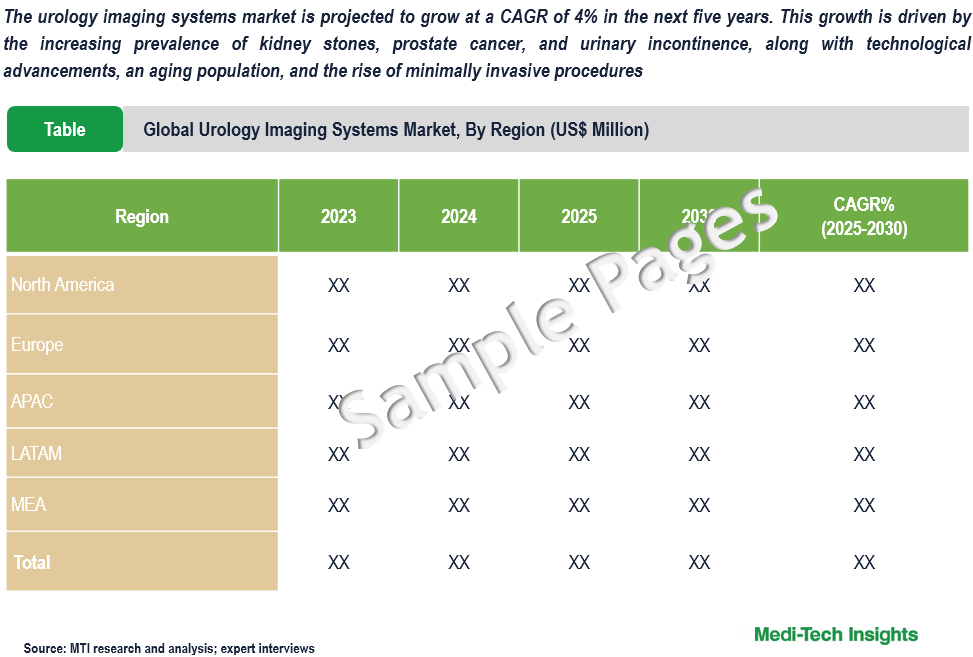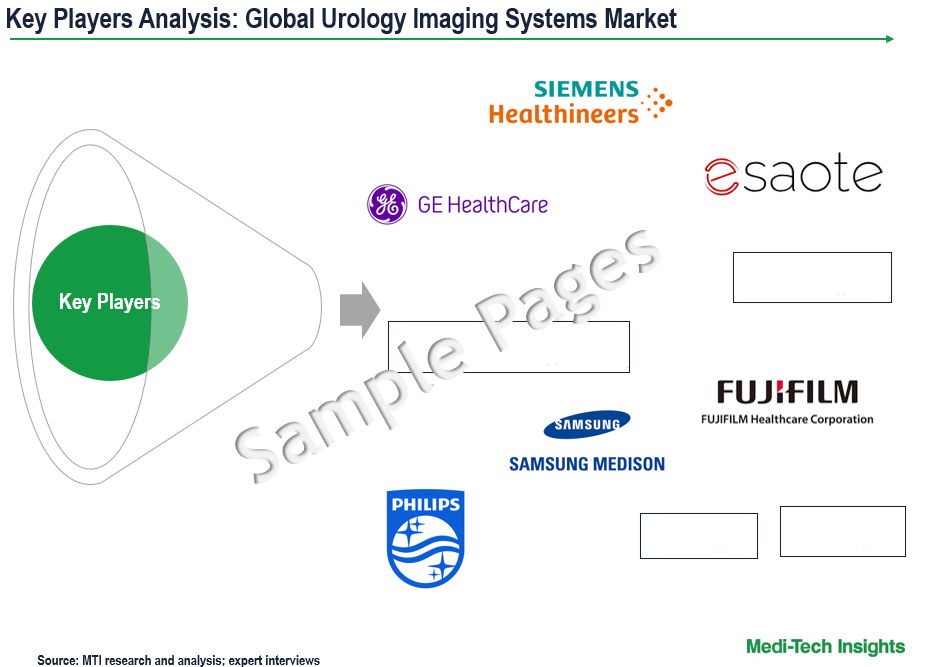
Global Urology Imaging Systems Market Size & Trends Report Segmented by Product (Ultrasound, X-Ray, CT, Others), Application (Diagnostic, Interventional), End-user (Hospitals, Diagnostic Imaging Centers, Others) & Regional Forecast to 2030
The urology imaging systems market is projected to grow at a CAGR of 4% in the next five years. This growth is driven by the increasing prevalence of kidney stones, prostate cancer, and urinary incontinence, along with technological advancements, an aging population, and the rise of minimally invasive procedures. Expanding healthcare infrastructure in emerging economies further supports market expansion. However, the high costs of advanced imaging systems and a shortage of skilled professionals pose challenges to widespread adoption. To learn more about the research report, download a sample report.
Report Overview
Urology imaging systems include advanced diagnostic tools such as ultrasound, X-ray, CT, MRI, and AI-powered imaging for detecting and monitoring urological conditions. These are specialized diagnostic tools designed to visualize the urinary tract, including the kidneys, ureters, bladder, and urethra. These systems are used to detect and diagnose urological conditions like kidney stones, urinary tract infections, prostate disorders, and bladder cancer. These technologies enable early detection, real-time monitoring, and precise guidance during minimally invasive procedures. The increasing adoption of these imaging systems in hospitals, diagnostic centers, and specialty urology clinics is enhancing diagnostic accuracy and patient outcomes.
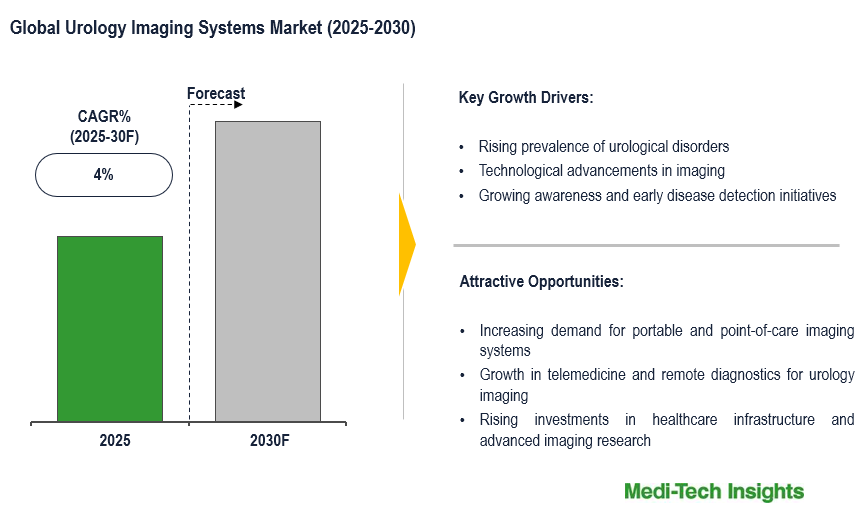
To learn more about this report, download the PDF brochure
Increasing Demand for Early Detection and Precision Diagnosis
One of the primary drivers of the urology imaging systems market is the growing demand for early detection and precision diagnosis. Urological conditions such as prostate cancer and bladder cancer often progress silently, making early and accurate diagnosis critical for effective treatment. Advanced imaging modalities, particularly multiparametric MRI and contrast-enhanced ultrasound are revolutionizing early detection by providing high-resolution images of soft tissues and tumor characterization. Additionally, AI-driven imaging solutions are enhancing diagnostic accuracy by analyzing patterns and detecting abnormalities with greater precision. As healthcare systems prioritize early-stage disease detection to improve patient outcomes and reduce treatment costs, the demand for urology imaging systems continues to rise. The integration of AI and machine learning into imaging workflows further boosts efficiency, enabling faster and more reliable diagnoses.
AI Integration in Urology Imaging for Enhanced Diagnostic Accuracy
A key advancement shaping the urology imaging systems market is the integration of artificial intelligence (AI) to improve diagnostic accuracy and workflow efficiency. AI-powered imaging software can analyze vast amounts of radiological data, detect anomalies with greater precision, and assist radiologists in making faster and more reliable diagnoses. One of the most notable applications is in prostate cancer detection, where AI algorithms enhance the interpretation of multiparametric MRI scans, reducing false positives and minimizing unnecessary biopsies. Additionally, AI-driven automation in ultrasound imaging aids in real-time anomaly detection, guiding clinicians in accurately diagnosing conditions like hydronephrosis or bladder tumors. AI is also streamlining workflow by automating image segmentation, annotation, and reporting, thereby reducing radiologists' workload and improving turnaround times. As regulatory approvals for AI-based imaging tools increase, their adoption in urology practices is expected to accelerate, leading to improved diagnostic confidence and better patient care outcomes.
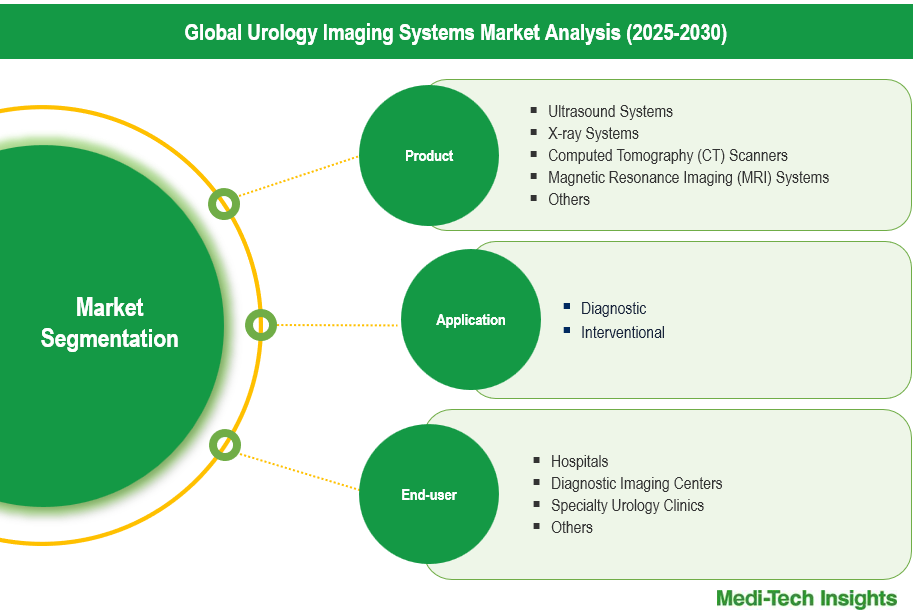
To learn more about this report, download the PDF brochure
Competitive Landscape Analysis
The global urology imaging systems market is marked by the presence of established and emerging market players such as Koninklijke Philips N.V.; GE Healthcare; Siemens Healthineers; Esaote S.p.A.; Samsung Medison Co. Ltd.; FUJIFILM Holdings Corporation; Hitachi Medical Corporation; Canon Medical Systems; Mindray Medical International Limited among others. Some of the key strategies adopted by market players include new product development, strategic partnerships and collaborations, and geographic expansion.
Report Scope
| Report Scope | Details |
| Base Year Considered | 2024 |
| Historical Data | 2023 - 2024 |
| Forecast Period | 2025 – 2030 |
| Growth Rate | 4% |
| Market Drivers |
|
| Attractive Opportunities |
|
| Segment Scope | Product, Application, and End-user |
| Regional Scope |
|
| Key Companies Mapped | Koninklijke Philips N.V.; GE Healthcare; Siemens Healthineers; Esaote S.p.A.; Samsung Medison Co. Ltd.; FUJIFILM Holdings Corporation; Hitachi Medical Corporation; Canon Medical Systems; and Mindray Medical International Limited among others |
| Report Highlights | Market Size & Forecast, Growth Drivers & Restraints, Trends, Competitive Analysis |
Global Urology Imaging Systems Market Segmentation
This report by Medi-Tech Insights provides the size of the global urology imaging systems market at the regional- and country-level from 2023 to 2030. The report further segments the market based on product, application, and end-user.
Market Size & Forecast (2023-2030), By Product, USD Million
- Ultrasound Systems
- X-ray Systems
- Computed Tomography (CT) Scanners
- Magnetic Resonance Imaging (MRI) Systems
- Others
Market Size & Forecast (2023-2030), By Application, USD Million
- Diagnostic
- Interventional
Market Size & Forecast (2023-2030), By End-user, USD Million
- Hospitals
- Diagnostic Imaging Centers
- Specialty Urology Clinics
- Others
Market Size & Forecast (2023-2030), By Region, USD Million
- North America
- US
- Canada
- Europe
- UK
- Germany
- France
- Italy
- Spain
- Rest of Europe
- Asia Pacific
- China
- India
- Japan
- Rest of Asia Pacific
- Latin America
- Middle East & Africa
Key Strategic Questions Addressed
- What is the market size & forecast of the urology imaging systems market?
- What are historical, present, and forecasted market shares and growth rates of various segments and sub-segments of the urology imaging systems market?
- What are the key trends defining the market?
- What are the major factors impacting the market?
- What are the opportunities prevailing in the market?
- Which region has the highest share in the global market? Which region is expected to witness the highest growth rate in the next 5 years?
- Who are the major players operating in the market?
- What are the key strategies adopted by players?
- Introduction
- Introduction
- Market Scope
- Market Definition
- Segments Covered
- Regional Segmentation
- Research Timeframe
- Currency Considered
- Study Limitations
- Stakeholders
- List of Abbreviations
- Key Conferences and Events (2025-2026)
- Research Methodology
- Secondary Research
- Primary Research
- Market Estimation
- Bottom-Up Approach
- Top-Down Approach
- Market Forecasting
- Executive Summary
- Urology Ultrasound Devices Market Snapshot (2025-2030)
- Segment Overview
- Regional Snapshot
- Competitive Insights
- Market Overview
- Market Dynamics
- Drivers
- Rising prevalence of urological disorders
- Increasing adoption of point-of-care and portable ultrasound systems
- Rising awareness and screening initiatives for early disease detection
- Growing preference for non-invasive and radiation-free diagnostic tools
- Technological advancements in ultrasound imaging
- Restraints
- High initial cost of advanced ultrasound systems
- Limited access to high-end ultrasound technology in low-income regions
- Variability in diagnostic accuracy due to operator dependency
- Opportunities
- Expansion of tele-ultrasound services for remote urological assessments
- Rising investments in contrast-enhanced and elastography ultrasound techniques
- Increasing demand for wearable ultrasound devices for real-time bladder monitoring
- Key Market Trends
- Advancements in fusion imaging integrating ultrasound with MRI/CT scans
- Development of fully automated ultrasound-guided biopsy systems
- Unmet Market Needs
- Industry Speaks
- Global Urology Ultrasound Devices Market Size & Forecast (2023-2030), By Type, USD Million
- Introduction
- Cart-based
- Handheld
- Portable
- Global Urology Ultrasound Devices Market Size & Forecast (2023-2030), By Application, USD Million
- Introduction
- Diagnostic
- Therapeutic
- Global Urology Ultrasound Devices Market Size & Forecast (2023-2030), By Disease, USD Million
- Introduction
- Kidney Disorders
- Prostate Disorders
- Bladder Disorders
- Others
- Global Urology Ultrasound Devices Market Size & Forecast (2023-2030), By End-user, USD Million
- Introduction
- Hospitals
- Specialty Clinics
- Diagnostic Centers
- Others
- Global Urology Ultrasound Devices Market Size & Forecast (2023-2030), By Region, USD Million
- Introduction
- North America Urology Ultrasound Devices Market Size & Forecast (2023-2030), By Country, USD Million
- US
- Market Size & Forecast, By Type (USD Million)
- Market Size & Forecast, By Application (USD Million)
- Market Size & Forecast, By Disease (USD Million)
- Market Size & Forecast, By End-user (USD Million)
- Canada
- Market Size & Forecast, By Type (USD Million)
- Market Size & Forecast, By Application (USD Million)
- Market Size & Forecast, By Disease (USD Million)
- Market Size & Forecast, By End-user (USD Million)
- US
- Europe Urology Ultrasound Devices Market Size & Forecast (2023-2030), By Country, USD Million
- UK
- Market Size & Forecast, By Type (USD Million)
- Market Size & Forecast, By Application (USD Million)
- Market Size & Forecast, By Disease (USD Million)
- Market Size & Forecast, By End-user (USD Million)
- Germany
- Market Size & Forecast, By Type (USD Million)
- Market Size & Forecast, By Application (USD Million)
- Market Size & Forecast, By Disease (USD Million)
- Market Size & Forecast, By End-user (USD Million)
- France
- Market Size & Forecast, By Type (USD Million)
- Market Size & Forecast, By Application (USD Million)
- Market Size & Forecast, By Disease (USD Million)
- Market Size & Forecast, By End-user (USD Million)
- Italy
- Market Size & Forecast, By Type (USD Million)
- Market Size & Forecast, By Application (USD Million)
- Market Size & Forecast, By Disease (USD Million)
- Market Size & Forecast, By End-user (USD Million)
- Spain
- Market Size & Forecast, By Type (USD Million)
- Market Size & Forecast, By Application (USD Million)
- Market Size & Forecast, By Disease (USD Million)
- Market Size & Forecast, By End-user (USD Million)
- Rest of Europe
- Market Size & Forecast, By Type (USD Million)
- Market Size & Forecast, By Application (USD Million)
- Market Size & Forecast, By Disease (USD Million)
- Market Size & Forecast, By End-user (USD Million)
- UK
- Asia Pacific (APAC) Urology Ultrasound Devices Market Size & Forecast (2023-2030), By Country, USD Million
- China
- Market Size & Forecast, By Type (USD Million)
- Market Size & Forecast, By Application (USD Million)
- Market Size & Forecast, By Disease (USD Million)
- Market Size & Forecast, By End-user (USD Million)
- Japan
- Market Size & Forecast, By Type (USD Million)
- Market Size & Forecast, By Application (USD Million)
- Market Size & Forecast, By Disease (USD Million)
- Market Size & Forecast, By End-user (USD Million)
- India
- Market Size & Forecast, By Type (USD Million)
- Market Size & Forecast, By Application (USD Million)
- Market Size & Forecast, By Disease (USD Million)
- Market Size & Forecast, By End-user (USD Million)
- Rest of Asia Pacific
- Market Size & Forecast, By Type (USD Million)
- Market Size & Forecast, By Application (USD Million)
- Market Size & Forecast, By Disease (USD Million)
- Market Size & Forecast, By End-user (USD Million)
- China
- Latin America (LATAM) Urology Ultrasound Devices Market Size & Forecast (2023-2030), USD Million
- Market Size & Forecast, By Type (USD Million)
- Market Size & Forecast, By Application (USD Million)
- Market Size & Forecast, By Disease (USD Million)
- Market Size & Forecast, By End-user (USD Million)
- Middle East & Africa (MEA) Urology Ultrasound Devices Market Size & Forecast (2023-2030), USD Million
- Market Size & Forecast, By Type (USD Million)
- Market Size & Forecast, By Application (USD Million)
- Market Size & Forecast, By Disease (USD Million)
- Market Size & Forecast, By End-user (USD Million)
- Competitive Landscape
- Key Players and their Competitive Positioning
- Key Player Comparison
- Segment-wise Player Mapping
- Market Share Analysis (2024)
- Company Categorization Matrix
- Dominants/Leaders
- New Entrants
- Emerging Players
- Innovative Players
- Key Strategies Assessment, By Player (2022-2025)
- New Product Launches
- Partnerships, Agreements, & Collaborations
- Mergers & Acquisitions
- Geographic Expansion
- Key Players and their Competitive Positioning
- Company Profiles*
(Business Overview, Financial Performance**, Products Offered, Recent Developments)
- Koninklijke Philips N.V.
- GE Healthcare
- Siemens Healthineers AG
- Esaote
- Canon Medical Systems
- Samsung Medison Co., Ltd.
- FUJIFILM SonoSite, Inc.
- Mindray Medical International Limited
- Konica Minolta Inc
- Other Prominent Players
Note: *Indicative list
**For listed companies
The study has been compiled based on extensive primary and secondary research.
Secondary Research (Indicative List)
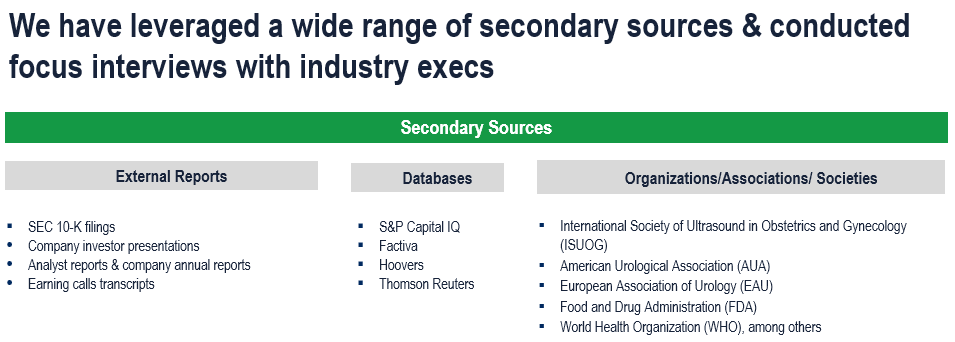
Primary Research
To validate research findings (market size & forecasts, market segmentation, market dynamics, competitive landscape, key industry trends, etc.), extensive primary interviews were conducted with both supply and demand-side stakeholders.
Supply Side Stakeholders:
- Senior Management Level: CEOs, Presidents, Vice-Presidents, Directors, Chief Technology Officers, Chief Commercial Officers
- Mid-Management Level: Product Managers, Sales Managers, Brand Managers, R&D Managers, Business Development Managers, Consultants
Demand Side Stakeholders:
- Stakeholders from Hospitals, Diagnostic Imaging Centers and Others
Breakdown of Primary Interviews

Market Size Estimation
Both ‘Top-Down & Bottom-Up Approaches’ were used to derive market size estimates and forecasts
Data Triangulation
Research findings derived through secondary sources & internal analysis was validated with Primary Interviews, Internal Knowledge Repository and Company’s Sales Data

